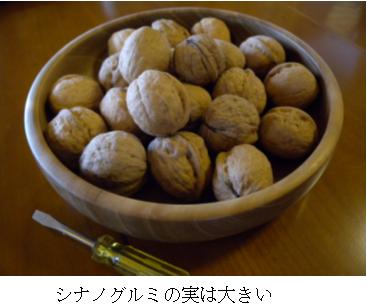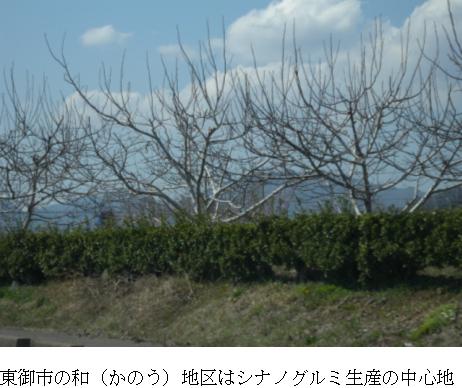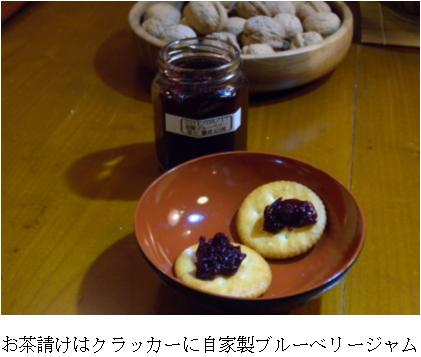今日はなんだか寒いし天気も悪いので、ガーデンの小屋に入って薪ストーブで暖まりましょう。
(この時期も相変わらずストーブを焚いています・・・)

仕事が一段落したら、お茶の時間です。
ガーデンの小屋(たまにサテライトオフィスとしても活用)には、いろいろなお茶を用意しております。何種類かの日本茶、コーヒー、紅茶、台湾茶のほかに、自家製の野草茶もたくさんあります。なにしろお茶が大好きなのです。
クワの葉茶、カキドオシ茶、スギナ茶、ドクダミ茶など。すべてソフィアート・ガーデンの中で採取した、天然自然(もちろん無農薬)の葉を天日・陰干しして作ったお茶です。湿気防止にシリカゲルを入れ、密閉して保管すれば長期に保存できます。だいたい1年以内には消費してしまうのですが。特にクワの葉茶は緑茶に負けず劣らずおいしくて、さすがはカイコの大好物です。
そしてお茶のおやつには、、東御(とうみ)市の信濃胡桃(シナノグルミ)の実です。清潔なマイナスドライバーを胡桃の割れ目に当てて、軽くテコのように動かすと、子供の力でもいとも簡単に割れます。生でポリポリ、リスのように食べると、おいしくて癖になるおやつです。この胡桃は殻が薄く、個体差はあるものの片手で割れるほど薄いものもありますので、ちょっとゲストを驚かせる余興として使えそうです。さらにすばらしいことには、実入りが良く、その薄い殻の中にびっしり肉厚の胡桃が詰まっており、味も濃くおいしいので一度知るとほかの胡桃には手が出なくなります。

ちなみに信州産のクルミは全国のクルミの総生産量の約8割にも及び、その大半は東御産です。
シナノグルミは、古い時代に大陸から渡って来たテウチグルミ(カシグルミ)と明治時代にアメリカから持ち込まれたペルシャグルミ(セイヨウグルミ)が自然交雑して誕生したとされ、たくさんの種類があるようです。
私どもは自家製のパンの中に、いつもこの胡桃を混ぜて焼いていますので、私どもの主要な栄養源の一つとなっています。
ところでガーデンやその周辺の雑木林にはオニグルミが自生しており、たくさんの実を落としています。
しかし、これがまた小さくて殻が固くて厚く、これを割るのは根性かテクニックが必要です。最初の頃こそ、ものめずらしさもあり一所懸命に拾いましたが、今では、そこかしこに転がっているオニグルミを蹴飛ばしてしまいます。私どもが苦労して食べるよりも、リスに差し上げた方がお互いの幸せになるようです。

もし、オニグルミを食べようと思えば、いくつかの段階を経なければなりません。まず、よく熟した実を選別します。時期はずれの落果ははじきましょう。そして殻のまわりの果皮が黒く溶けるまで水につけてきれいに洗い流し、殻をむき出しにして自然乾燥します。その後、少し水につけてフライパンで軽く炒る(炒りすぎると胡桃の油がすべて溶け出てしまうので注意)と、硬く閉ざされた殻の割れ目が、ほんのわずかに開きます。そこですかさず包丁の刃の尻部分をその割れ目にあてて、まな板の上でコン、と軽く叩けば簡単に割れます。
地元の人に聞くと、ひたすら金槌でガンガン割る、という人もいます。金槌だと肝心の実まで砕けて何も残らないのでは、と心配になりますが、それほどまでに固く苦労の多い、しかし、苦労の割にはなんとも少ない収穫となります。
とはいえ、野生の風味は栽培種とはひと味違って、濃厚で絶品です。リスはあの厚い固い殻を歯で開けるので、さぞやたいへんだと思いますが、あのおいしさと栄養価、そしてエネルギーの高さを考えるとどんな苦労をしてでも食べたい、と思うのはリスにとって当然でしょう。

国内のスーパーなどで出回るのは、アメリカ(カリフォルニア)産や中国産の胡桃がほとんどだそうですが、これらは熱で乾燥しているため、当地の自然乾燥の胡桃とは栄養価や風味には大きな差があります。やはり、東御の胡桃は別格だと思います。
お茶請けには胡桃だけでなく、自家製のブルーベリージャムや杏のコンポート、ジャムなどなど、素朴で楽しいお菓子が並び、たまには胡桃のかけらをヤマガラにプレゼントしたりして分かち合って楽しんでおります。弊社にいらっしゃる折は、どうぞソフィアート・ガーデンのお茶の時間にあわせてお越しくださいね。
『ソフィアート・ガーデン物語』
有限会社ソフィアート スタッフM( 竺原 みき )
The Tale of Sophiart Garden
>>To the Previous Story | >>To the Next Story
Chapter 9
“Tea Time” – April 20, 2012
Today, the weather is cold and gloomy, so let’s step into the garden hut and warm ourselves by the wood stove.
(Even at this time of year, we’re still using the stove…)
Once the work has settled down, it’s time for tea.
In the garden hut (which occasionally doubles as a satellite office), we have a variety of teas prepared. There’s an assortment of Japanese teas, coffee, black tea, and Taiwanese tea, as well as plenty of homemade herbal teas. After all, we love tea.
Some of our favorites include mulberry leaf tea, creeping charlie tea, horsetail tea, and houttuynia tea. These are all made from naturally grown, pesticide-free leaves harvested right here in Sophia Art Garden, carefully dried in the sun or shade. Stored properly with silica gel to prevent moisture, they can last a long time—though we usually consume them within a year.
Among them, mulberry leaf tea is especially delicious, rivaling green tea in flavor. No wonder silkworms love it so much!
For today’s tea snack, we have Shinano walnuts from Tōmi City.
Using a clean flathead screwdriver, you can easily crack them open by inserting it into the natural seam and giving a gentle twist—so easy that even a child can do it. Eating them raw, crunching away like a squirrel, makes for an addictive treat.
These walnuts have notably thin shells, and some are so delicate that you can break them with just one hand, which always surprises guests. Best of all, the nuts inside are thick and packed full, with a rich, intense flavor that makes it hard to go back to any other kind of walnut once you’ve tried them.
Incidentally, Shinshu walnuts account for about 80% of Japan’s total walnut production, with most of them coming from Tōmi City.
Shinano walnuts are said to be a natural hybrid of two species:
• The Japanese walnut (also called Teuchi-gurumi or Kashi-gurumi), which arrived from the continent long ago.
• The Persian walnut (also known as the Western walnut), which was introduced from America during the Meiji era.
Over time, these two varieties naturally crossbred, resulting in a diverse range of Shinano walnuts.
At home, we always bake these walnuts into our homemade bread, making them a staple part of our diet.
Meanwhile, the garden and surrounding woodlands are home to wild Japanese walnuts (Onigurumi), which drop their nuts all over the place.
However, these are much smaller, with incredibly thick and hard shells. Cracking them open requires either sheer determination or a special technique. When we first encountered them, we were eager to collect them, but now… we often end up just kicking them aside. It seems far better to let the squirrels have them—they appreciate them more than we do.
That said, if you really want to eat wild Japanese walnuts, you need to follow several steps:
1. Select ripe nuts – Discard any unseasonal fallen ones.
2. Soak and clean them – Let them sit in water until the outer husks turn black and dissolve, then wash them thoroughly.
3. Dry them naturally – This helps the shells set.
4. Lightly roast them – Soak them in water for a moment, then gently roast them in a frying pan. (Be careful not to over-roast, or the walnut oil will be lost.)
Once roasted, the shells develop tiny cracks. At this point, use the spine of a knife blade to tap along the crack on a cutting board, and they should split open easily.
Some locals, however, say they just hammer away with a mallet.
That sounds risky—wouldn’t that smash the nuts inside too?
In any case, wild walnuts require a lot of effort for very little reward.
That being said, their flavor is incredibly rich and unique, unmatched by cultivated varieties. It’s no wonder squirrels go through such trouble to crack those tough shells—considering
their taste, nutrition, and energy content, the effort is well worth it!
In Japan, most walnuts sold in supermarkets are from the U.S. (California) or China, but because they’re heat-dried, their flavor and nutritional value differ significantly from the naturally air-dried ones found in Tōmi.
Shinano walnuts truly stand in a league of their own.
For tea time, we don’t just have walnuts—we also enjoy homemade blueberry jam, apricot compote, and other simple yet delightful treats. Sometimes, we even share little walnut pieces with the friendly birds, like the Varied Tit, making tea time a moment of connection with nature.
If you ever visit us, please feel free to drop by during our tea time at Sophia Art Garden. We’d love to share a warm drink and a taste of nature with you.
The Tale of Sophiart Garden
Chapter 9:“Tea Time”
Miki Jikuhara, Sophiart Karuizawa

